Letters to Lichen
Author(s)
Adriana Knouf
In haar tekst ‘Dearest Zen (Letters to Lichen)’ presenteert kunstenaar en wetenschapper Adriana Knouf toekomstige liefdesbrieven aan korstmossen: de samengestelde symbioten van schimmels en algen of cyanobacterieën. Bezien door de lenzen van de ‘xenologie’ (Knouf’s term voor de studie, analyse en ontwikkeling van het vreemde, buitenaardse en andere) en trans*-tijdelijkheden, onderzoekt ze manieren om te leren van, en opgetogen mee te doen met, intimiteiten en uitwisselingen tussen verschillende organismen.

Dearest,
Now that I see xen, I can’t unsee xen.
I realize now that xe’ve really been there all along, attached simultaneously to the substrates of life and non-life. The trees that I pass as I leave my studio every day, which are covered with shades of green and orange that burst into saturation when infused with the drizzle of the grey city. Or as I walk to my class, speckles of yellow that are spread like grains of symbiosis on the bridge’s concrete railing.
I didn’t really get to know xen until quite recently. But being on these hormones has heightened all of my senses—I smell more, colors are more vibrant, my skin feels with such intensity. Julia Serano told the world about this too. All of xeur color had thus simply lingered in my background, merging with the entities xe’re intertwined with. I had never looked through a loupe at xeur thallus, seen the crusty bits adhered to the granite, observed the prickly rhizines at 40 times magnification. Perhaps that’s what xen prefers—to be miniscule, hiding in plain sight, existing, slowly, while everything else goes to hell, at least a hell for some of the humans that are around xen.
I’ve been doing some deep research about xen, and I’m not entirely sure what to think. I read something a few months ago that I want to share with xen. Maybe xen already know about this, we really know nothing about how xeur sharing of experience may occur between and beyond our comprehension. But here’s the story: In 2008, some of xen were launched to the International Space Station, at the furthest reaches of our atmosphere, beyond which no life we know of should be able to survive. Once xen were there, shuttled in a complicated, brittle space plane whose design was necessary to allow us fragile humans to survive beyond the atmosphere—once xen were there, xen were attached to the outside of the station, beyond the life-support systems, faced with the ravages of space: vacuum, extreme hot and cold, no water.
And the astronauts left xen there. For 559 days. Xen went around and around the Earth nearly 9000 times.
And yet—after all this time—the space shuttle ferried xen back to the surface of Earth. And the scientists went to work on xen. They cut and prodded and magnified and tested and examined. Their results? That xen were still alive. That xen survived the inhospitable environment of space. Xen joined the waterbears and other creatures that the scientists found to also endure these conditions.
So, I read this recently about xen and became fascinated, but also slightly disturbed, because of the detached way xen were examined by the scientists. I started to weave together a story about how the resilience of xen resonated with the resilience of queers and t-girls and other such xenobodies of the more-than-humans. I linked it with my own artwork that went to space, TX-1, and the hormone medications that were encased inside of the tiny resin spheres. These medications included a fragment of my testosterone blocker pill and a fragment of my estrogen patch. The patch fragment I sent was from one I had already worn, so parts of me went to space too.
Like xen, TX-1 also came back to Earth, intact. Unlike xen, however, it had to be encased in a sealed vessel, protected from the ravages xen experienced. Also there was another sphere that went with my medications, a tiny handmade paper sculpture meant to leave room for a letter, much like this one. Our circumstances are different, yet this resilience is shared. Perhaps this was all a pedestrian relationship to construct—it would have to be unpacked more, as resilience is complicated by our distinctive material forms, and also its embedding within this thing called capitalism—but it certainly resonated with many in my conversations about it.
This story caused me to start looking for xen everywhere, to tell others of xeur existence, to begin to further intertwine my life—and the lives of the others who did workshops with me—with xeurs. It’s caused me to think alongside xen about deeper times, about ways in which we humans may need to change how we live here on Earth, about how we may want to reconsider our human forms for future extreme environments, in space or on Earth. Because of course our imaginings of space, and how to live there, are really imaginings about how we want to live here.
Some of xen that are living with me in my studio these days have probably felt me talking to my friends about this recent sci-fi novella by Becky Chambers called To Be Taught, If Fortunate. My queer sister told me about it. At a surface level it’s another story of the exploration of exoplanets by humans in a near-future. But, the details matter here: rather than trying to terraform these worlds to make them suitable for human habitation, the astronauts transform themselves. These transformations allow them to deal with reduced gravity, or extreme cold, or increased radiation, or toxic atmospheres. And they do so by putting on new transdermal patches for each planet. Patches!!! Just like us older t-girls do to get our estrogen.
So this is an exploration story with a difference. One that suggests that we ought to be more humble when we leave the Earth. That maybe the transformation has to come from within rather than without. It strangely connects to this other history I might have told some of xen about. Do xen remember this word “cyborg”? It was quite popular for us a couple of decades ago. Well, here’s the thing: when it was first being developed as a term, in the 1960s, it was precisely about this necessity to transform human bodies for outer-space travel—of altering humans, using biomedical and mechanical means, to deal with the challenges of outer space. Two men—Manfred Clynes and Nathan Kline—wrote: “Altering man’s bodily functions to meet the requirements of extraterrestrial environments would be more logical than providing an earthly environment for him in space.” Of course these men could only think of astronauts as men then, but some of us now know better. So this desire to change ourselves for outer space—rather than changing space or other planets for ourselves—has been with us for a while.
But am I still being too anthropocentric? Perhaps we should instead learn something from xen and xeur ability to survive in a vacuum and thrive again when on terra firma. Maybe we shouldn’t even be sending bipedal human bodies to space at all. Maybe what we really need is to start bringing ourselves even closer to xen. I’m going to think about this more deeply and get back to xen about it.
Xeurs,
Adriana
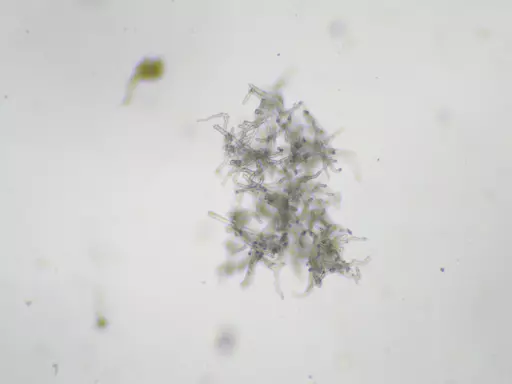
I’ve been reading Octavia E. Butler again. Her conjured worlds intertwine the speculative with the actual by drawing out the resonances between our pasts and what we imagine might come to be in the future.
This time I’m reading the Xenogenesis trilogy. I can’t give xen the full outline of the books here—perhaps I will read it to some of xen someday—but the gist is this: a ravaged, damaged, inhospitable Earth; an alien entity with three genders, including one that is adept in minute genetic engineering; the aliens select certain humans to propagate the species; and such propagation occurs through the merging of humans and aliens, creating hybrids. This causes predictable distress, not only over the non-consensual nature of the merging (which is a probable reference by Butler to the legacies of slavery), but also over the very mixing of humans and aliens—literal xenophobia. Yet some hybrids revel in their new possibilities. There is ultimately caring and love across the species: aliens, humans, and hybrids.
So, hybridity requires a lack of purity. As a process, those entities that are seen as separate, come together and merge into something else. As times pass the hybrid may be misunderstood as a pure entity. But closer analysis reveals the variegated vestiges of multiple contributing entities. Xeur photobiont and mycobiont so tightly interwoven together, one producing energy derived from the sun’s photons, the other providing water and protection. This is a relationship where the component beings can be seen separately—the photobiont and mycobiont—but are also completely interdependent on each other. And this is without considering all of the other creatures that call xeur ecosystem “home.”
I’ve recently been developing this body of thought that I call “xenology,” referring to the study, analysis, and development of the strange, alien, and other. Hybrids, against xenophobia. A celebration of the transformation of an entity into something it wasn’t. Transition. Not without pain or challenges. Not as blasé celebration, but rather as the complicated welcoming of change-as-universe-given.
Xenology relates intimately to xen. Xeur symbioses provide one possible route of change for us—for me. I already know transformation via transition. There is a juxtaposition of time that occurs as I go through a second puberty in my forties. Transitioning has also been noted as key to Butler’s work. Dagmar Van Engen has written about the trans futurities that are latent in the Xenogenesis trilogy, and especially regarding the growth of the hybrids. Butler’s future in Xenogenesis hasn’t occurred yet—and perhaps it never will—but maybe it still provides the oomph that can set us onto a new trajectory, here and now.
Maybe there’s something deeper to explore. About how xeur being and my being can be brought together in our own particular hybrid. What form this hybrid takes, I don’t know yet. Maybe this would give me some access to xeur temporalities too, in a way that I can’t access as a century-bound entity. I’m going to start researching this and will keep xen updated on my progress.
Until soon,
Adriana
Dearest,
I’ve been wondering why I don’t use “you” and “your” to refer to xen.
We know that we can’t refer to xen as an individual. The fact that we even have species names for xen is itself such a relic of the scientific hubris that believes we can create an arboral taxonomy. Xanthoria elegans— xen that were launched to the space station—what does this name even mean? Why does it focus so much on xeur mycobiont, but entirely ignores the photobiont Trebouxia? Why even mark xen as a species when in fact xen are a combination of multiple species? I read that there are even xen growing in xen! And bacteria too! Xen have a microbiome!
My bioart students and I were recently discussing an article by David Griffiths which argues that “we are all lichens” insofar as we are all composed of multiplicities of species—the vaunted “microbiome” that is all the rage now. He linked this to ideas of queerness, because of how the multiplicity of the body is itself a challenge to heteronormative, singular, and isolated notions of the human. The fact that “we have never been individuals” links up with xeur very definition. Queerness is (ideally) about these non-vertical minglings and intertwinings that break down the typical western construct of the human—that is, as a being which is whole, separate from “nature,” dominant, controlling, and authoritative. Queerness breaks from this tradition to manifest a nonhierarchical being, or at least attempts to do so, given that we have so much to unlearn.
Because of all this, I needed a new pronoun to refer to xen. Something that sounded a bit plural, a bit xeno, a bit gritty and difficult. As long as I write to xen in English—or frankly any human language of the moment—there will be a forced seriality to my thoughts. We can’t communicate easily in the simultaneous or nonlinear—although the Dadaists attempted to do so in some of their poetry. So please forgive this impossibility of the moment, and I hope xen can accept the “xen” pronoun as my foray into moving a bit closer to xeur sensibility.
Xeurs,
Adriana

As I continue to research xen, I become more and more mesmerized. This seems to be a vestige of my own scientific training in biology, which I both embrace and recoil from. What makes me want to know the most intimate details about xen? What is it about the accumulation of knowledge about xen that gives me such joy? And then why do I want to share so much of it with others? Why don’t I talk more about how I feel when I rub the bristles along xeur apothecia?
But maybe I’m getting too explicit for these letters. We don’t know who might end up reading them alongside us . . .
I really wanted to use this letter to write to xen about xeur times and how I want to feel them. During my research I read the following, written by lichenologist Thomas Nash: “A few arctic/alpine lichens may even live to over 1,000 years, perhaps even up to c. 4500 years, an age rivaling the oldest vascular plants.” Through these extreme lifetimes, and the steady regularity of xeur rate of growth, xen are used as a form of temporal measurement: “lichenometry.” Xeur growth is compared to things that we know have definite dates—like gravestones—and then used to calibrate a scale. Throughout all of these years xen grow so slowly that we measure the amount in units of millimeters.
There’s something profound about this, compared to the pace with which humans relate to the Earth. Obviously inside xeur cells the molecules and reactions occur at a rapid speed, much like inside my body. But outwardly, xeur times proceed at rates that make the hustle and worries of my life become . . . well, meaningless. In a way this realization is also pedestrian, similar to what I wrote in the last letter. But I continue to be drawn to it nevertheless. These times of xen that overlap with my times—unfolding and intertwining through rhythms that cannot be easily predicted, that interfere constructively and destructively, boosting and suppressing resonances in equal measures—suffice it to say that these times are awesome, in the truest sense of the word.
I yearn to experience xeur time. Especially as I read about different forms of panspermia, such as lithopanspermia—which suggests that xen might have been able to exist in the miniscule crevices in rocks that were then hurtled into interstellar space, traveling in the void for perhaps millions of years, only to randomly enter another planet’s atmosphere, breaking apart upon impact with the ground, and becoming exposed to another atmosphere. There are a lot of “ifs” in that concept, of course, but that can’t stop me from wondering . . .
If this has possibly happened in the past, then it could also possibly happen in the future, and this time it could be directed. Chosen, even. And maybe, just maybe, it doesn’t have to be just xen that go. Perhaps some part of me, or of others here, could come along for the very long journey.
Let me ponder this for a bit,
Adriana
Dearest,
I’ve been sublimating.
Really, my letters have been too precise, too detached.
Truth is, I want to be xen; intertwined with some aspect of xeur being; to escape this human form that feels rather constraining and limited. Consciousness feels overrated at times. Or perhaps too many of us have lost the ability to be more fluid in our material being—even though from what I understand, transforming oneself is not without danger and the potential of permanent effects.
Dammit, there I go again, sublimating. I enter into the didactic to escape the emotional.
All I want is a form of communion with xen. This isn’t some desire to just “live forever.” I know it would mean giving up the privileges of being human, but, as xen know, I’ve already given up some pretty intense privileges to live as a t-girl.
I dream of being down there, nestled amongst the hyphae. Perhaps I’d be held too tight, like when xen squeeze the algae. But nevertheless I’d also be protected by xen from the harshness just beyond xeur cortex mass. Living in this mess we call “symbiosis.”
Xen and I both know that this word “symbiosis” is too often merely a smokescreen, that the exchanges are never so smooth and equal, that parasitism and control shift places with altruism and love in dynamics that can’t be easily mapped out.
But love also feels like the wrong word to use with xen here. It’s much queerer than that. This is an affection that twists outward from me to xen and clasps onto xeur hyphae and rhizines and back to me again. It’s not about possession and hierarchy and the naming of the relationship. It’s a caring and a submission simultaneously. It’s for us and for all who constitute us. And maybe others might see us and make their own changes to how they affect others.
Right now, though, I can’t be with xen intimately. There’s no way to take a part of me and interface it with xen and make something viable. But wait—and wait I think xen can—I’m working on it.
With hope, dearest,
Adriana
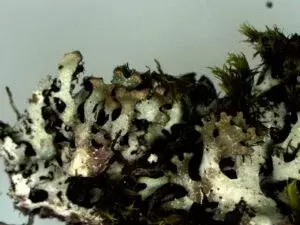
Are my letters to xen a xenolyst for the temporalities that we so imprecisely, so misleadingly, term “the future”? A xenolyst is something that makes a particular temporality more likely to happen, just as a catalyst of a chemical reaction lowers the activation energy just enough to make the improbable probable.
The equations of the cosmos—the equations we know now, at least—can move backward in time just as easily as forward. But even this is too simple. Some of our physicists are arguing that time doesn’t exist at all, that it’s merely the result of relations between particular events that we can observe. In fact, no one has ever observed time. Physicist Carlo Rovelli says, “the existence of the variable time is a useful assumption, not the result of an observation.” It’s perhaps a cruel cosmic joke then that so many humans alive today see their lives progressing in only one forward temporal direction, even as the math could tell them otherwise. “Progress” is a misnomer, as it relies on this incessant, illusory forward motion.
I feel out of joint from this motion.
I feel pierced by events that I can never rationally experience. Maybe they are the dampened remnants of reverberatory moments that have decayed as they travelled through the space-time foam. These events feel as real to me as the unaccounted wisp of air that just tingles the hairs on my forearm, causing a hunt for the source. What if we are affected through non-linear causality, through a coming event that happened in some moment we imperfectly see as “the future”? We are torn apart by the histories of capitalism, colonialism, racism, sexism, homophobia, and transphobia. If this can be acknowledged about those moments we see as in “the past”, why can we not also feel the advancing blade of “the future” that slices into “the now”?
But xen . . . I have a feeling xen senses this already. Xeur coverings upon rocks and bark that encroach, slowly, upon all the surfaces of the planet. Xeur potential provenance beyond this planet. Xeur fragments that break off a long-lived specimen, only to settle again elsewhere, some other place-time—xen seem to dispense with hierarchical linearity. I desire this.
I’m still working on the merging. I’ve been able to separate many of xen—algae on one plate, fungi on another. I know that this hurts. It’s a temporary waypoint on a longer journey. I’m beginning to introduce parts of me to the mix. As usual with hybrids there is a lot of rejection. But I just have to get the right proportions, the correct conditions . . . I’m getting there. Just wait a little longer. Xen will recognize my signal.
Longingly,
Adriana
Dearest,
Yes yes YESYESYESYES we are finally crushed together in this rock the pull of the earth recedes and it begins to get colder than I ever could know before
I feel things coming to rest
. . .
. . . . . .
. . . . . .
. . . . . .
. . . . . .
dearest can xen sense it the new pull downward on our tendrils it’s quite different from where we left a bit stronger and the stars aren’t where we remember them we’ve moved but they’ve moved even more the time is such a different time now but this place also has water it’s seeping into us now we’re bulging yet again may we encounter beings who yearn for the affections we both extend and desire
. . . . . .
. . . . . .
. . . . . .
. . . . . .
there that moment when our rhizines burrowed into the crevices on this rock upon a world with different stars we caused those reverberations may the part of we that was once not part of we feel this moment as it spreads throughout the spacetime foam so as to know what to do then
Bibliography
Ahmadjian, Vernon. The Lichen Symbiosis. Waltham: Blaisdell Publishing Company, 1967.
Alexander, Will. Across the Vapour Gulf. New York: New Directions Books, 2017.
Brandt, Annette, Jean-Pierre de Vera, Silvano Onofri, and Sieglinde Ott, “Viability of the Lichen Xanthoria Elegans and Its Symbionts After 18 Months of Space Exposure and Simulated Mars Conditions on the Iss,” International Journal of Astrobiology 14, no. 3 (July 2015), pp. 411–425, https://doi.org/10.1017/S1473550414000214.
Butler, Octavia E. Lilith’s Brood, New York: Aspect, 2000.
Chambers, Becky. To Be Taught, If Fortunate. London: Hodder & Stoughton, 2019.
Clynes, Manfred E. and Nathan S. Kline. “Cyborgs and Space.” Astronautics 13 (September 1960), pp. 26–27, 74–76.
Crick, F. H. C. and L. E. Orgel. “Directed Panspermia,” Icarus 19, no. 3 (July 1973), pp. 341–46, https://doi.org/10.1016/0019-1035(73)90110-3.
Van Engen, Dagmar. “Metamorphosis, Transition, and Insect Biology in the Octavia E. Butler Archive,” Women’s Studies 47, no. 7 (2018), pp. 733–754, https://doi.org/10.1080/00497878.2018.1518620.
European Space Agency, “Milestones in Astrobiology,” Space for Life: Human Spaceflight Science Newsletter, no. 7 (April 2015), http://wsn.spaceflight.esa.int/docs/HumanSpaceflightScienceNewsletters/2015/Newsletter_Apr_2015.pdf.
Gabrys, Jennifer. “Sensing Lichens,” Third Text 32, nos. 2–3 (2018), pp. 350–367.
Knouf, Adriana. “Fragments of Xenology,” 2021, https://tranxxenolab.net/writings/fragmentsofxenology/.
Knouf, Adriana. “Xenological Temporalities in the Search for Extraterrestrial Intelligence, Lovecraft, and Transgender Experiences,” Studies in the Fantastic, no. 9 (2020), pp. 23–43.
Kranner, Ilse, Richard Beckett, and Ajit Varma, eds. Protocols in Lichenology: Culturing, Biochemistry, Ecophysiology and Use in Biomonitoring (Berlin: Springer-Verlag, 2002).
Lücking, Robert, Steven D. Leavitt, and David L. Hawksworth, “Species in Lichen-Forming Fungi: Balancing Between Conceptual and Practical Considerations, and Between Phenotype and Phylogenomics,” Fungal Diversity 109, no. 1 (September 2021), pp. 99–154, https://doi.org/10.1007/s13225-021-00477-7.
Nash, III, Thomas H., ed. Lichen Biology, Cambridge: Cambridge University Press, 2008.
R. Gary Raham, “Exploiting the Lichen Liaison,” The American Biology Teacher 40, no. 8 (November 1978), pp. 470–79, https://doi.org/10.2307/4446360.
Rovelli, Carlo. Reality Is Not What It Seems: The Journey to Quantum Gravity, London: Penguin, 2016.
Serrano, Julia. Whipping Girl: A Transsexual Woman on Sexism and the Scapegoating of Femininity, Berkeley: Seal Press, 2007.
tranxxeno lab, “TX-1,” 2020, https://tranxxenolab.net/projects/tx-1/.
More in this edition

In dit korte afro-futuristische verhaal, geschreven door Amiri Baraka in 1995, ontdekt een ongenaamde uitvinder een manier om terug te reizen door de tijd – door muziek. “I duwde de Anyscape in de Rhythm Spectroscopic Transformation. En toen stemde ik het af zodat Anywhereness kan worden gecombineerd met de Reappearance als muziek!” legt de uitvinder uit. “Nu voeg ik Rhythm Travel toe! Je kunt verdwijnen en verschijnen waar en wanneer die muziek speelde.”

Tijdsgebonden drag, erohistoriografia, chronomornativiteit, geilheid onder het kapitalisme, ritme, dansen en 'crip time'. Dit zijn een paar van de onderwerpen die worden genoemd in het interview met Elizabeth Freeman, queer theoreticus en auteur van de boeken Time Binds: Queer Temporalities, Queer Histories (2010) en Beside You In Time: Sense Methods & Queer Sociabilities in the American 19th Century (2017), en Amelia Groom, co-editor van de 'No Linear Fucking Time' focus op Prospections.
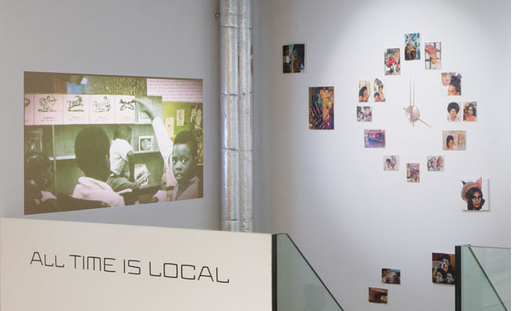
Reclamations of time, geared toward community and temporally “local” orientations, animate this interview with artists and activists Black Quantum Futurism (Rasheedah Phillips and Camae Ayewa), who draw from Afrofuturism, quantum physics, and “Afrodiasporic traditions of space and time that are not locked into a calendar’s date or a clock’s time." As discussed in the interview (which first appeared in Toward the Not Yet: Art as Public Practice, published by BAK and MIT Press, 2021), BQF’s recent and forthcoming projects directly challenge imperial and colonial standardizations of time.

Dit essay, oorspronkelijk gepubliceerd in het Journal of Interdisciplinary Voice Studies, is een onderdeel van muzikant en schrijver JJJJJerme Ellis’s veelzijdige project The Clearing. Ellis beschrijft het bos en zijn open plekken als “plekken van weerstandige ‘black oralities’” en verkent hoe stotteren, Blackness en muziek kunnen figureren binnen de praktijken van het weigeren van hegemonisch tijdsbeheer, spraak en ontmoeting.
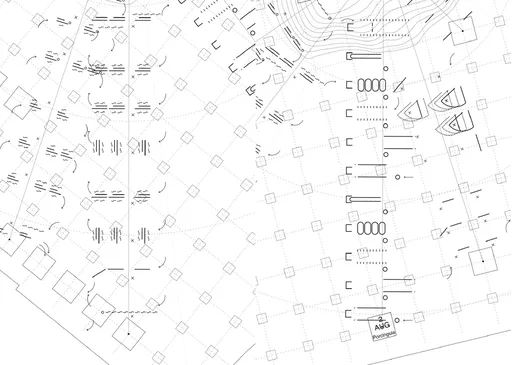
Wanneer inheemse gemeenschappen worden gevraagd om bewijs te tonen van hun traditionele connectie met hun voorouderlijke landen, respecteert wat Westerse legale instanties accepteren als documentatie niet volledig hoe stammencultuur en traditionele manieren van kennisoverdracht werken. Het onderzoeksproject en boek The Language of Secret Proof (2019), geschreven door Nina Valeria Kolowratnik, reageert op de ervaring met de productie van bewijsmateriaal van bewoners in Jemez Pueblo, New Mexico. Dit boek bevecht de omstandigheden waaronder de rechten van inheemse volken om traditioneel land te beschermen en terug te winnen worden behandeld in het wettelijk kader van de Verenigde Staten.

SEA – SHIPPING – SUN (2021) is een korte film en meditatie over maritieme handelsroutes, geregisseerd door Tiffany Sia en Yuri Pattison. De film werd opgenomen over de span van twee jaar, maar is geedit om het eruit te laten zien alsof het één dag is, van zonsopgang tot zonsondergang. De film speelt de soundtrack van scheepsberichten uit het archief van BBC Radio 4 uitzendingen. SEA – SHIPPING – SUN werd gemaakt met de intentie om de kijker slaperig of relaxed te laten voelen, en verzamelt een visie van verstrengeling. Wij worden achtergelaten met de overblijfselen van geschiedenis: een zachte, wiegende waltz over de zee.
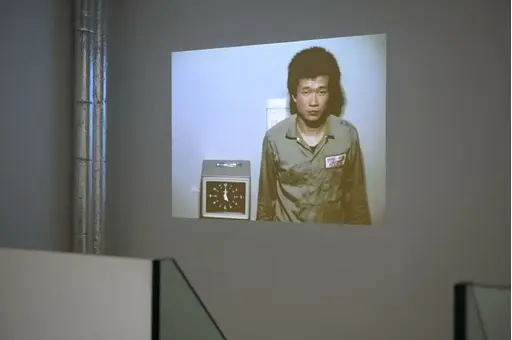
In dit essay reageert Amelia Groom op Tehching Hsieh's werk Time Clock Piece (One Year Performance 1980–1981) (1980-1981), een van de stukken die te zien is als onderdeel van de tentoonstelling No Linear Fucking Time bij BAK, basis voor actuele kunst, Utrecht. Door een lezing van het gelijktijdige anti-werk lied 9 to 5 (1980) van Dolly Parton reflecteert Groom op de historische verschuivingen in de manieren waarop werknemers werden en nog steeds worden uitgebuit door technieken van tijdsdiscipline.

Grappling with the imposed linearity of timespace as a fundamental feature of colonial violence, this essay by Promona Sengupta (also known as Captian Pro of the interspecies intergalactic FLINTAQ+ crew of the Spaceship Beben) proposes a mode of time travel that is “untethered from colonial imaginations of the traversability of time and space.” While coloniality has enforced an externalization of time and space as things outside the body, Sengupta affirms practices of relational care and survival that restore time and space as embodied realities.

Weird Times (2021) is een chapbook van 30 pagina's door kunstenaars Tiffany Sia en Yuri Pattison over de tijd aflezen en hegemonie. Het bevat Sia's schrijfwerk en beelden geselecteerd door Pattison, en geeft een korte geschiedenis weer van de ontiwkkeling van technologieën voor tijdregistratie. De klok wordt gedemonteerd als een politiek werktuig, een metronoom van dwang en een versneller van oorlogsmacht. Uit deze mechanieken verschijnen weerstandige ‘counter-tempos'.
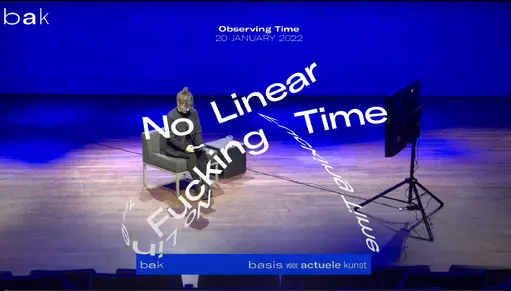
Een online gesprek met performance kunstenaar Tehching Hsieh, schrijver Amelia Groom en schrijver en curator Adrian Heathfield, geleid door Rachael Rakes, BAK curator Public Practice, op 20 januari 2022. Het gesprek neemt Hsieh's werk als uitgangspunt voor het bespreken van onder andere perfomatieve tijd, werktijd, gaten en ritmes van uithoudingsvermogen.
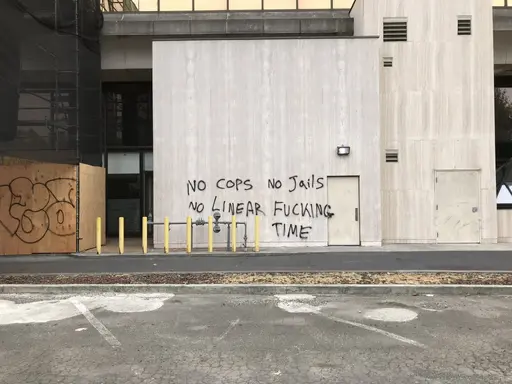
The No Linear Fucking Time Bibliografie is een zich ontwikkelend naslagwerk waarin wetenschappelijke en artistieke teksten worden gebundeld die betrekking hebben op de verscheidene onderzoekslijnen binnen dit project.

In ‘Reclaiming Time: On Blackness and Landscape’ (voor het eerst gepubliceerd in PN Review issue 257 in 2021), bekijkt dichter en schrijver Jason Allen-Paisant de geracialiseerde maatschappelijke contexten en moderne milieuconstructen die ‘Zwarte levens disproportioneel beroven van de voordelen van tijd.’ Hij put uit zijn poëziebundel Thinking with Trees om een koloniale epistemologie van de natuur te schetsen, en de rol van poëzie te benadrukken in het genereren van vormen van Zwart verwantschap en politiek bewustzijn, gebaseerd op een hernieuwd gevoel van ‘diepe tijd’. De vraag of het mogelijk is om middels poëzie ‘tijd terug te claimen’ staat centraal in de tekst.
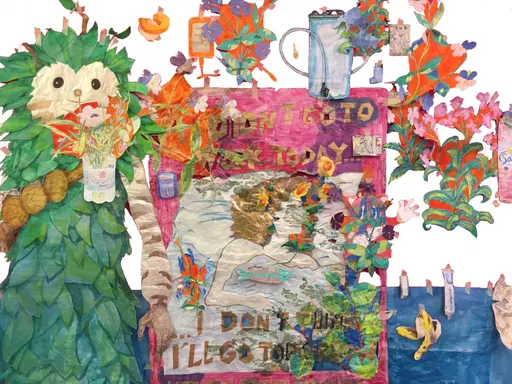
Als hij door de ‘Nothing To Declare’ uitgang van het vliegveld London Stansted loopt, ziet Sam Keogh drie grensbewakers: een varken, een eenhoorn en een bezorgde cartoonklok. Pig Eater is het script voor een monoloog dat voor het eerst opgevoerd werd als onderdeel van Keogh’s tentoonstelling Sated Soldier, Sated Peasant, Sated Scribe, in Goldsmiths Centre for Contemporary Art, Londen in 2021. Het verweeft fantasieën over overvloed en de afschaffing van werk; over feesten en rusten; over sabotage, anachronisme en het ‘opfokken’ van lineaire tijd.

In dit gesprek met Walidah Imarisha (voor het eerst gepubliceerd in Toward the Not Yet: Art as Public Practice, BAK en MIT Press, 2021), schetst de schrijver en activist haar concept van ‘visionaire fictie’ als een verbeeldingspraktijk om toekomsten te verlossen van het bolwerk van lineaire tijd. Imarisha put uit haar werk als strafrechtelijk abolitionist, en spreekt specifiek tot de bewegingen en ideeën die voortkomen uit de Zwarte strijd in de Verenigde Staten. Ze benadrukt dat we ons bij het veranderen van de toekomst moeten verhouden tot het verleden: ‘specifiek vanuit een kader gericht op gedekoloniseerde, niet-lineaire dromen van vrijheid die gegrond zijn in de strijd van gemeenschappen van kleur voor autonomie en bevrijding van kolonialisme.’

In haar essay ‘In Some Places the Not-Yet Has Long Been Already’ (voor het eerst gepubliceerd in Toward the Not Yet: Art as Public Practice, uitgegeven door BAK, basis voor actuele kunst en MIT Press, 2021) put Elizabeth A. Povinelli uit haar werk als onderdeel van het Karrabing Film Collective. In de tekst contrasteert ze de temporele oriëntatie van het laat-koloniale liberalisme – getroebleerd door de op handen zijnde catastrofes van een totale klimaatinstorting – met de voorouderlijke catastrofes van kolonialiteit en slavernij, die zowel van het verleden als het heden zijn. Deze voorouderlijke catastrofes, aldus Povinelli, ‘blijven groeien uit de grond die kolonialisme en racisme hebben bewerkt, in plaats van op te duiken aan de horizon van liberale vooruitgang.’

‘Dysfluent Waters’ is onderdeel van het multidimensionale project The Clearing van muzikant en schrijver JJJJJerome Ellis, respectievelijk een boek uitgegeven door Wendy’s Subway en een gelijknamig album uitgebracht door NNA Tapes in 2021. Hij ziet het bos en haar open plekken als ‘plaatsen waar al eeuwenlang verzet plaatsvindt middels zwarte gesproken cultuur.’ Ellis onderzoekt hoe stotteren, zwartheid, en muziek een rol kunnen spelen bij verzetspraktijken tegen dominante voorschriften voor de beleving van tijd, spraak en ontmoeting.

In haar tekst ‘Dearest Zen (Letters to Lichen)’ presenteert kunstenaar en wetenschapper Adriana Knouf toekomstige liefdesbrieven aan korstmossen: de samengestelde symbioten van schimmels en algen of cyanobacterieën. Bezien door de lenzen van de ‘xenologie’ (Knouf’s term voor de studie, analyse en ontwikkeling van het vreemde, buitenaardse en andere) en trans*-tijdelijkheden, onderzoekt ze manieren om te leren van, en opgetogen mee te doen met, intimiteiten en uitwisselingen tussen verschillende organismen.

In ‘Immortals: on the Ancient Future Lives of Stone and Plastic’ verweeft Marianne Shaneen verhalen, geschiedenissen en ontologieën van twee materialen: steen en plastic. Als quasi-onsterfelijke substanties zijn steen en plastic getuige van de catastrofale effecten van uitbuitende lineariteit, terwijl hun levensloop veel langer is dan dat van een mensenleven. Dit essay verweeft deze twee materialen, die schommelen tussen het geologische en synthetische, en die diep ingebed zijn in industrieel-kapitalistische ontwikkeling.

‘The Clearing: Melismatic Palimpsest’ is onderdeel van het multidimensionale project The Clearing van muzikant en schrijver JJJJJerome Ellis, respectievelijk een boek uitgegeven door Wendy’s Subway en een gelijknamig album uitgebracht door NNA Tapes in 2021. Hij ziet het bos en haar open plekken als ‘plaatsen waar al eeuwenlang verzet plaatsvindt middels zwarte gesproken cultuur.’ Ellis onderzoekt hoe stotteren, zwartheid, en muziek een rol kunnen spelen bij verzetspraktijken tegen dominante voorschriften voor de beleving van tijd, spraak en ontmoeting.